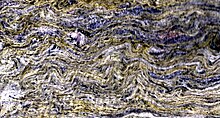
Back عزل حراري Arabic Aislante térmicu AST Топлоизолация Bulgarian Aïllant tèrmic Catalan Tepelný izolant Czech Ynysydd thermol Welsh Wärmedämmung German Θερμομόνωση Greek Varmoizolado Esperanto Aislante térmico Spanish
This article needs additional citations for verification. (May 2021) |

Thermal insulation is the reduction of heat transfer (i.e., the transfer of thermal energy between objects of differing temperature) between objects in thermal contact or in range of radiative influence. Thermal insulation can be achieved with specially engineered methods or processes, as well as with suitable object shapes and materials.
Heat flow is an inevitable consequence of contact between objects of different temperature. Thermal insulation provides a region of insulation in which thermal conduction is reduced, creating a thermal break or thermal barrier,[1] or thermal radiation is reflected rather than absorbed by the lower-temperature body.
The insulating capability of a material is measured as the inverse of thermal conductivity (k). Low thermal conductivity is equivalent to high insulating capability (resistance value).[2] In thermal engineering, other important properties of insulating materials are product density (ρ) and specific heat capacity (c).
- ^ "Thermal Break Technology - IQ Technical". IQ Glass Technical. 28 July 2017. Retrieved 2019-10-16.
- ^ Ashley, Jake (26 December 2022). "Choosing the Correct Insulation for Your Home". Homaphy.